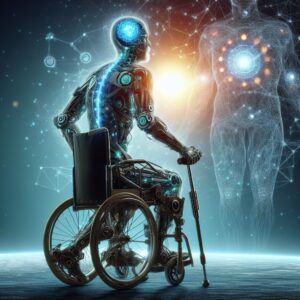Exoskeleton technology, once the realm of science fiction, has emerged as a transformative force in healthcare and mobility. These wearable robotic devices, resembling a suit or frame, augment human capabilities, aiding in mobility, rehabilitation, and even industrial applications. The integration of exoskeletons signifies a profound shift in how technology enhances human abilities, offering a glimpse into a future where physical limitations are overcome.

Revolutionizing Mobility and Rehabilitation
Exoskeletons serve as powerful tools in restoring mobility for individuals with mobility impairments or disabilities. These robotic suits provide support, assistance, and enhanced strength, enabling users to walk, stand, or perform activities they might not have otherwise been able to accomplish independently. In rehabilitation settings, exoskeletons aid in retraining motor functions, aiding recovery after injuries, strokes, or spinal cord damage, offering patients a path to regain mobility and independence.
Diversity in Applications
Beyond healthcare, exoskeletons find applications in various sectors. In industrial settings, these wearable devices assist workers in lifting heavy loads and reducing physical strain, thereby enhancing productivity and reducing the risk of workplace injuries. Moreover, exoskeletons have ventured into the realm of sports, augmenting athletes’ performance and minimizing fatigue during training and competitions.
Technological Advancements and Challenges
Advancements in exoskeleton technology continue to refine these devices. Lightweight materials, advanced sensors, and more efficient actuators contribute to enhanced comfort, increased agility, and improved functionality. However, challenges persist.
The Future of Exoskeleton Technology: Empowering Mobility and Rehabilitation
The trajectory of exoskeleton technology holds immense promise. Continued research and development aim to address existing challenges, making exoskeletons more accessible, cost-effective, and adaptable for a broader range of users. As advancements pave the way for more sophisticated and versatile exoskeletons, these devices are poised to play an increasingly pivotal role in healthcare.
The evolution of exoskeleton technology represents a groundbreaking leap in enhancing human mobility and rehabilitation. These wearable robotic devices, once the stuff of science fiction, have emerged as real-world solutions. Exoskeletons serve as futuristic suits, providing support, strength, and mobility to users with spinal cord injuries.
Beyond aiding mobility, exoskeletons play a pivotal role in rehabilitation. In clinical settings, these devices facilitate motor function retraining, assisting patients in regaining lost mobility after injuries or strokes. The precise control and assistance offered by exoskeletons serve as invaluable tools in the journey toward recovery.

The applications of exoskeleton technology extend beyond healthcare. Industries have embraced these wearable devices to minimize physical strain and reduce the risk of workplace injuries. In industrial settings, exoskeletons support workers by augmenting their strength, offering enhanced lifting capabilities, and promoting ergonomic movements.
However, the evolution of exoskeletons faces challenges, including the need for more adaptable designs, cost considerations, and addressing power supply limitations. Despite these hurdles, ongoing advancements in lightweight materials, sensors, and actuators continue to refine exoskeleton technology.
Looking ahead, the future of exoskeletons appears promising. Continued research aims to surmount existing challenges, making these devices more accessible and adaptable for a broader spectrum of users. As exoskeleton technology evolves, it will not only continue to transform mobility and rehabilitation but also pave the way for a world where physical limitations are surmounted.
Conclusion: Empowering Human Potential
Exoskeleton technology stands as a testament to the seamless integration of robotics and human potential. By augmenting mobility, aiding rehabilitation, and enhancing productivity, these wearable devices herald a future where physical limitations are no longer insurmountable barriers. As technology continues to evolve, exoskeletons promise to revolutionize the way we perceive and support human mobility and performance.
For more Article like this, visit our Website Here
